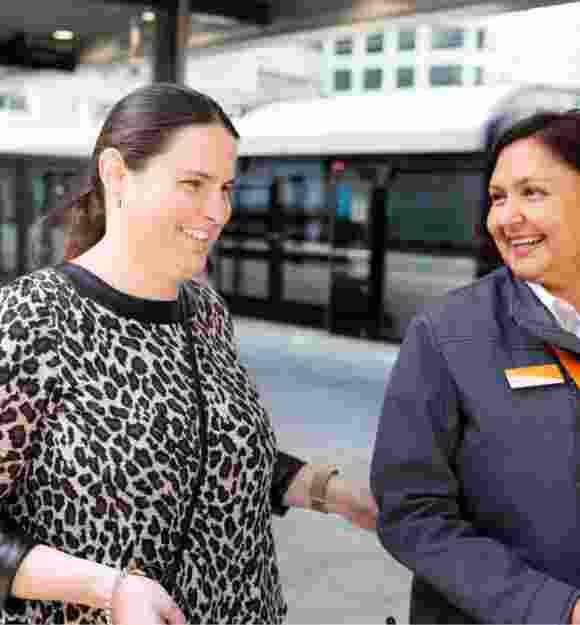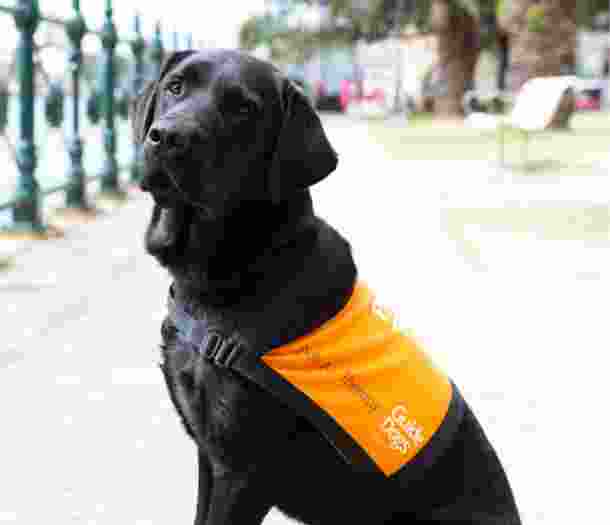On this page:
What is self-advocacy?
Advocacy is about speaking out to make things better for you and for others, achieving independence and equality.
It’s a really important way of making sure that things change for the better for people with blindness or low vision, and educating the wider community on respectful and lawful interactions with a person who has blindness or low vision.
Most people with blindness or low vision experience issues with access at some stage of their life and, from our experience, the probability of this happening with a Guide Dog is especially high.
In most circumstances it is best for you to lead this individual advocacy process as you have all the relevant information, it gives you the control over the situation, and it is very important that the organisation you are lodging your feedback hears about your specific needs or concerns.
Some people can be concerned that they are making a fuss, or that things will never change. In fact, it is your right to be treated equally and it is very important to speak up when you need to.

How can GDV help?
We encourage self-advocacy and provide resources to support this.
We encourage self-advocacy and provide resources to support this. We can provide educational resources to businesses and organisations unclear of the legislation. For more in-depth individual advocacy cases we can refer clients to Blind Citizens Australia.

Providing you with ‘on the spot’ resources:
- All Guide dog Handlers have been provided a wallet-sized Access Card detailing their rights under the law. Please use this if you are asked or challenged by anyone regarding your right of access.
- This toolkit provides you with contact information to head you in the right direction to advocate individually if something happens that you need to provide feedback about for change.
- If the issue persists call us on 1800 804 805 and we can send an education pack to the business/organisation concerned.
- If still unresolved we can refer you and your concern to Blind Citizens Australia– the peak advocacy organisation in our sector.
Steps in self-advocacy
Here's how the process commonly plays out:
- Contact the organisation involved in the interaction – this might be by phone, email or letter, whichever you feel most comfortable with.
- If you are making a phone call then have your list of issues or friend with you so you can be sure you cover each of your points. You may want to document who you talk to and important things said. Note that if you record the conversation it is best to let the person you are speaking to know you are doing this to ensure you are legally covered.
- Most anti-discrimination obligations fall under the Disability Discrimination Act (DDA) 1992. It is often worth mentioning in any initial complaint, to ensure that the organisation realizes it has obligation. Most discrimination is not malicious, but done through ignorance of the law. If you want to mention the DDA then the following sections present the most common complaint areas: Sections 15-29: Assistance animals; Section 15: Discrimination in employment; Section 22: Education; Section 23: Access to premises; Section 24: Goods, services and facilities; Section 25: Accommodation
- If asking at the time doesn’t resolve the situation, or you don’t feel comfortable speaking up then and there (which is fine!), try to:
- think calmly about what has happened, identify the problem, and the impact it has on you. It’s understandable for you to feel upset, but advocacy is usually much more effective if it is done calmly and respectfully, aiming for improvement.
- think about what you want to happen. Do you want a change in a process or even a law, do you want an apology, or both?
- some people like to write down a few key points, or talk this through with a trusted friend or family member to prepare.
- If you feel comfortable at the time the issue occurs say something. For example, if a bus driver isn’t making the announcements you need, ask them to. If you are refused access with your Guide Dog, show your Guide Dog access card and politely point out your rights. (An important point here though is to distinguish between being questioned about your Guide Dog, and being refused. It is part of a business owner’s duty-of-care to other customers to check that dogs on their premises are authorised. An unfortunate result of the recent proliferation of assistance animals is that business owners are confused about identifying harnesses and coats. So if you are just being questioned about your dog, rather than directly refused, please don’t get angry but see it as a positive opportunity to educate the person involved. Using your Guide Dog Handlers card here is a great way to explain the law). For example, if you and your Guide Dog are refused access to a restaurant you could say “did you know that under the Disability Discrimination Act sections 15-29, you must allow my Guide Dog access to your restaurant when accompanying me?”
- If you don’t feel satisfied with the outcome then you may want to escalate your concern to a governing body or ombudsman. You can also go to Blind Citizens Australia (www.bca.org.au) who may be able to provide additional representation.
Contact details for public transport feedback
Directory of contact details for self-advocacy.
Oversees Public Transport. You can submit feedback and complaints to them on:
Phone: 1800 800 007
Online at: https://feedback.ptv.vic.gov.au/ptv-feedback
In person at PTV Hubs (locations – https://www.ptv.vic.gov.au/customer-service/ptv-hubs/)
In writing to: Customer Relations, Public Transport Victoria, PO Box 4724, MELBOURNE VIC 3001
They can pass complaints onto other transport organisations, or you can contact these directly.
Phone: 1800 800 807
Online: http://www.yarratrams.com.au/contact-us/getting-in-touch/customer-feedback/
In writing: Customer Feedback, Yarra Trams, GPO Box 5231, Melbourne, 3001, Victoria
Phone: 1800 800 807
Online: www.metrotrains.com.au
In writing: Metro Trains Melbourne, Customer Feedback, GPO Box 1880, MELBOURNE VIC 3001
Phone: 1800 800 007
Online: www.vline.com.au/contactus
In writing: V/Line Customer Relations, Reply Paid 5343, Melbourne VIC 3001
Phone: 1800 638 802
Online: http://taxi.vic.gov.au/about-us/feedback-form
In writing: GPO Box 1716, Melbourne VIC 3001
If dissatisfied you can escalate to the Public Transport Ombudsman.
The Public Transport Ombudsman deals with complaints about Victorian public transport that members of the community have been unable to resolve directly with the public transport operators.
Phone: 1800 466 865
Website: www.ptovic.com.au
Contact details for issues with government or local council
Directory of contact details for self-advocacy.
First contact the government department or local council concerned. If you are dissatisfied with the response, escalate to:
Victorian Ombudsman
The Victorian Ombudsman is an independent officer of the Victorian Parliament who investigates complaints about state government departments, most statutory authorities and local government. The Ombudsman investigates complaints about administrative actions and decisions taken by government authorities and about the conduct or behaviour of their staff. The Ombudsman is independent and impartial and provides a free service.
Phone: (03) 9613 6222
Website: www.ombudsman.vic.gov.au
Contact details for issues with private businesses
Directory of contact details for self-advocacy.
First, contact the business concerned. If you are dissatisfied with the response, escalate to:
Disability Services Commissioner
The Disability Services Commissioner can respond to complaints about Victorian disability services.
Phone: 1800 677 342
Website: www.odsc.vic.gov.au
Aged Care Complaints Commissioner
The Aged Care Complaints Commissioner provides a free service for anyone to raise their concerns about the quality of care or services being delivered to people receiving aged care services subsidised by the Australian Government.
Phone: 1800 550 552
Website: www.agedcarecomplaints.gov.au

Victorian Equal Opportunity and Human Rights Commission
Responsible for eliminating discrimination in Victoria. Offers information, education and consultancy services, conducts research and provides legal and policy advice.
Phone: 1300 292 153
Website: www.humanrightscommission.vic.gov.au
Victorian Civil and Administrative Tribunal (VCAT)
VCAT provides low cost, accessible, efficient and independent tribunal/dispute resolution proceedings relating to consumer matters, domestic building works, legal services, owners corporation matters, residential and retail tenancies disputes, real estate disputes.
Phone: (03) 9628 9900
Website: www.vcat.vic.gov.au
Further Advice and legal support
Directory of contact details for self-advocacy.
An online directory to help you find someone who can assist you with a complaint that you haven’t been able to resolve with the service provider yourself. Complaint line has information and links to dispute resolution schemes Australia-wide.
Website: www.complaintline.com.au
Promotes consumer protection and ethical trading and ensures that consumer protection laws are properly enforced.
Phone: 1300 55 81 81
Website: www.consumer.vic.gov.au
Represents the interests of Victorian people with disabilities.
Phone: 1300 309 337
Website: www.publicadvocate.vic.gov.au
A specialist community legal centre which promotes and protects the rights of people with a disability by providing free legal advice and representation in disability discrimination cases.
Phone: 1800 800 708
Website: www.disabilitylaw.org.au
Provide free legal services including information, referral, advice, casework assistance, community legal education, and policy and law reform. The National Association of Community Legal Centres does not provide legal advice but has created a database of community legal centres in each state and territory. To find a community legal centre near you, visit the National Association of Community Legal Centres (NACLC) website.
Phone: (02) 9264 9595
Website: www.naclc.org.au
Disability Discrimination Legal Service (DDLS) is a statewide independent community legal centre that provides free legal services in several areas including information, referral, advice, casework assistance, community legal education, and policy and law reform.
Phone: (03) 9654 8644
Website: www.communitylaw.org.au/clc_ddls
Information credit
About this self-advocacy toolkit.
The above directory information has been largely sourced from Blind Citizens Australia Victorian Toolkit which can be found at www.bca.org.au. Blind Citizens Australia exists to provide a voice for all Australians with blindness or low vision. They provide information, peer support, consultancy and can also assist with advocacy.
Ready to continue?
Seems like you have filled this form earlier. Let’s pick up where you left off.
